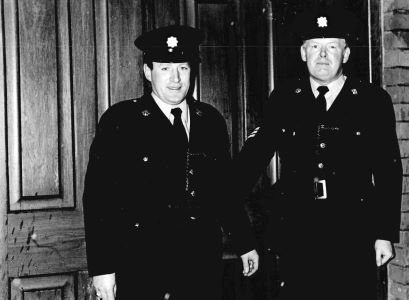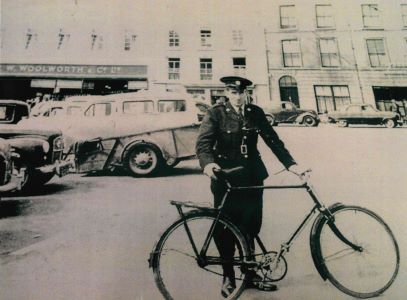AN GARDA SÍOCHÁNA, THE EARLY YEARS IN GALWAY

by Tom Kenny
After the truce, the R.I.C. handed over their barracks to the Irish Free State. One hundred years ago this month, the Government set up An Garda Síochána, an unarmed civic police force. Unfortunately, the first group of Gardaí who arrived in Galway by train had no barracks to go to, the Eglinton Street headquarters having been destroyed in an arson attack on the night of July 2nd, 1922. A search began for someplace to house the 23 Gardaí and that evening, they managed to find accommodation in The County Club. They stayed there for almost a year.
Work had begun on renovating the Eglinton barracks very quickly after the fire and in June 1923, Sergeant Daly and ten guards left the County Club and moved into the wing of the barracks that had been made habitable. It was expected at the time that the force would shortly take over the building in Dominick Street that had been occupied by the RIC. Civic stations were opened in various parts of the county.
The county was divided into 7 districts for police purposes and in 1924 had a chief superintendent, 7 superintendents, 81 sergeants and 276 guards. In 1914, the RIC had 2 county inspectors, 13 district inspectors, 13 head constables, 139 sergeants and 731 constables. By 1926, there were 63 Garda stations throughout Galway and they were already beginning to build up ‘splendid traditions’ exemplifying the true position of the law - cool and calm judgement and action.
The formidable red-brick Eglinton St. barracks had dormitory space on the top floor for 16 single guards, in fact for some 50 years, young single Gardaí were expected to move into the barracks living quarters, which meant they were always on call in the event of an emergency. In those early days, most of their duties were carried out on foot or by bicycle. They eventually got squad cars, but as late as 1959, the Chamber of Commerce were writing to the superintendent asking that these cars be supplied with radio call systems.

As a recruitment drive got underway in 1960, a local newspaper wondered “Where are the strapping young fellows we saw in uniform in the past. There was a time when first class recruit meant six feet. Guards now appearing on the streets are like mere boys compared with the material we are used to. They are all small, tidy and dapper. When one of the old brigade turns out with one of the new brigade, it looks like a father taking out a promising son who will one day grow up”.
Policing duties were generally quiet, thought there were times when there was extra pressure such as the visits of Presidents Kennedy and Reagan and Pope John Paul. The advent of the troubles in the north meant an increase in robberies throughout the country including Galway. There was a major post office robbery in 1972 when a postal worker was seriously injured and the Lynch's Castle bank robbery in 1974 resulted in the murder of Jerome O'Connor. The entire force countrywide were searching for a killer or killers of two young women when eagle-eyed local Gardaí picked up two English men named Shaw and Evans who were arrested, tried and convicted of the brutal murders.
Policing in Galway has undergone huge changes since. In 1986, the guards moved out of Eglinton Street and into a new complex on Mill Street and since then a new headquarters has been built on the Renmore Road. Computerisation, technological advances and new forms of communication have helped the force evolve into the highly sophisticated organisation it is today.
Our photographs today show a typical Garda patrolling Eyre Square on his bicycle in Eyre Square in the late 1950's, and Garda E. Mellette and Sergeant M. O'Malley pulling out the door following the last patrol out of Eglinton Street Station at 10pm on January 26th, 1986.
